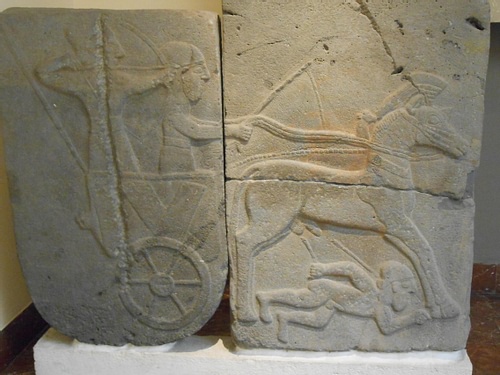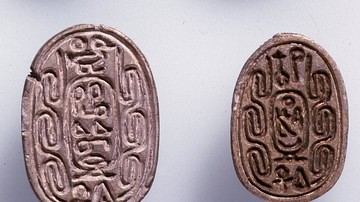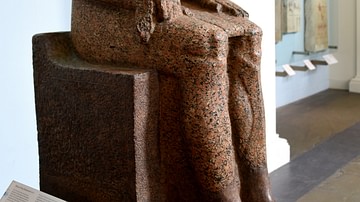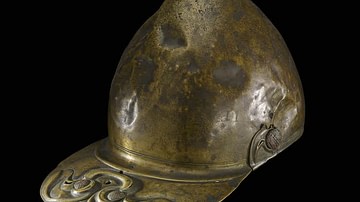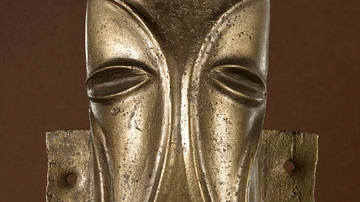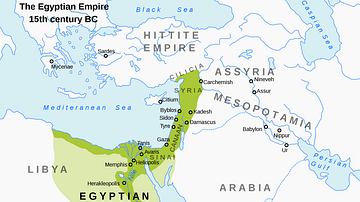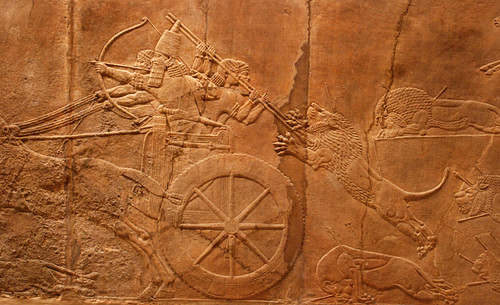
The chariot was a light vehicle, usually on two wheels, drawn by one or more horses, often carrying two standing persons, a driver and a fighter using bow-and-arrow or javelins. The chariot was the supreme military weapon in Eurasia roughly from 1700 BCE to 500 BCE but was also used for hunting purposes and in sporting contests such as the Olympic Games and in the Roman Circus Maximus.
Horses were not used for transport, ploughing, warfare or any other practical human activity until quite late in history, and the chariot was the first such application. Donkeys and other animals were preferred in early civilizations.
The Horse
The horse's main ecological niche was the Eurasian steppe; a very wide (4,800 km) and narrow (800 km on average) strip of grassland running roughly from Hungary to China, encompassing parts of what today is Ukranie, southern Russia, Kazakhstan, Uzbekistan, Turkmenistan, Kyrgyzstan, Tajikistan and Mongolia. For most of ancient history, the steppe - which means “wasteland” in Russian - was the home of nomadic societies whose economy was based on herding, complemented by hunting and, to a much lesser degree, sporadic, itinerant agriculture. No cities or settled communities existed in the steppe, save a very few spots.
Steppe dwellers domesticated the horse for the purpose of breeding it for food like sheep and other animals already domesticated. That process is unfortunately poorly understood, and it occurred sometime before 2500 BCE. The wheel, an invention imported from the Middle East, had arrived in the steppe around 3100 BCE. The invention of the chariot in the steppe - perhaps originally meant as an improved tool for hunting - occurred roughly by 2000 BCE, probably in the area just east of the southern Ural mountains, where the oldest chariots have been unearthed. The word for horse appears just around this date for the first time in Mesopotamia, when an increase in north-south trade through Iran is attested.
Invention of the Chariot
The chariot then became a moving platform from which soldiers could shoot at enemies. Arrows and javelins were the main weapons used by the fighter on board, while a second person drove the chariot. The tactic was to move constantly, in and out of the battle, shooting from a distance.
There is no clear explanation as to why humans invented the chariot first, before riding the horse directly, which seem more straightforward to us. A chariot was obviously more expensive than the horse alone, and chariots could not enter or properly manoeuver in landscapes where a mounted horse can, such as hills, marshes or forests. We know people tried mounting horses very early, as we have found drawings depicting it, but those seem rare experiments that did not seem to work. The most common scholarly suggestion is that horses at that time were weaker than in the present, unsuitable for supporting a man and only after a very long period of constant, selective breeding, did a stronger horse come into being. Horses started consistently to be mounted roughly a millennium and a half after the chariot was invented.
The “compound bow”, invented sometime during the second millennium BCE, was the final ingredient for the rise of a deadly ensemble. Bow and arrow were much older, and the innovation of the compound bow was the use of two types of materials, inside and outside the bow, which gave it considerably more power. Compound bows were able to accurately hit a target 300 m away, and penetrate an armour 100 m away. It was the preferred weapon of charioteers and later horseback riding societies. Its power is reflected in the fact that these bows were last used in war as recently as the 19th century CE by the Chinese, well into the age of firearms.

We have scarce knowledge of what happened with the communities in the steppe once the chariot was invented. We can assume that war intensified - and some evidence about it does exist -, and those who first or better grasped the new invention stormed their neighbours, sizing valuable hunting and pasturing land rights. We truly understand the impact of the chariot only when this new form of warfare came out of the steppes and into the settled, agricultural lands.
Charioteers & Warfare
The first reference to charioteers comes from Syria around 1800 BCE. Over the course of the next four centuries, chariots advanced into civilization, either by direct migration of steppe people or by diffusion, and it quickly came to be the preferred elite weapon.
Hittites established their first kingdom with the help of chariots c. 1700 BCE, and thereafter used them intensely; Hurrians, from somewhere near the Caucasus, penetrated in the Middle East and carved a kingdom for themselves that was to play an important role in that region, Mitanni, around 1500 BCE; Egypt's north was taken by charioteers called Hyksos c.1650 BCE, who established their own dynasties; in China the first dynasty appeared, the Shang (starting c. 1600 BCE), with an aristocracy of charioteers; Mycenaeans adopted the chariot in Greece, which likely helped them invade their more sophisticated Minoan neighbours (c. 1400 BCE); tribes called Kassites appeared driving chariots from Iran and took Babylonia, establishing their own dyansty (c. 1570 BCE), which was to last four centuries; and the steppe dwelling Aryans, charioteers as well, from c. 1500 BCE migrated south to what today is Iran, Pakistan and India, profoundly influencing the local culture, particularly establishing the basis for Hinduism. The famous king Darius the Great of the much later Persian Achaemenid Empire would proudly state his Aryan descent for good reason.
Everywhere, in Europe, the Middle East, India, and China, all rulers, from petty chiefs to great pharaohs, took the chariot as their master weapon. They started depicting themselves riding chariots, waging wars in chariots, including chariots and horses in their tombs as symbols of power, and so on. Their surrounding aristocracy, of course, followed suit, so the elite forces in every polity came to be charioteers. The horse came to be a valuable military asset, no longer a food source. Horse breeding became key for these states, and all powerful kings aspired to have the proper stables to supply their armies with chariots; imports from the steppes, though, long remained their major source.
The most famous chariot battle was that of Kadesh (1294 BCE), fought between the two superpowers of the time, Egypt and Hatti (Hittites), where some 50 chariots are presumed to have participated for each side. The small number of chariots compared to infantry troops is a good indicator of how effective the chariot was: in China, the ratio was up to 25 infantry soldiers per chariot.
Decline in Use
The use of the chariot declined very slowly, starting around 500 BCE (and yet, in some parts of Europe the technology was just arriving at that time). First and probably foremost, because horseback riding was developed in the steppes, and slowly but surely replaced the need for chariots. The first known forces mounting horses were those of the Scythians, steppe people who in the 7th century BCE attacked the Assyrian empire on horseback. Second, because infantry, formerly helpless against chariots, became more sophisticated due to the expanding use of iron weapons (from c. 1200 BCE onwards), and to new tactics in the form of phalanx formations. Fighting the invading Romans, the Celts were probably the last people who used chariots extensively, until around the 4th century CE.

